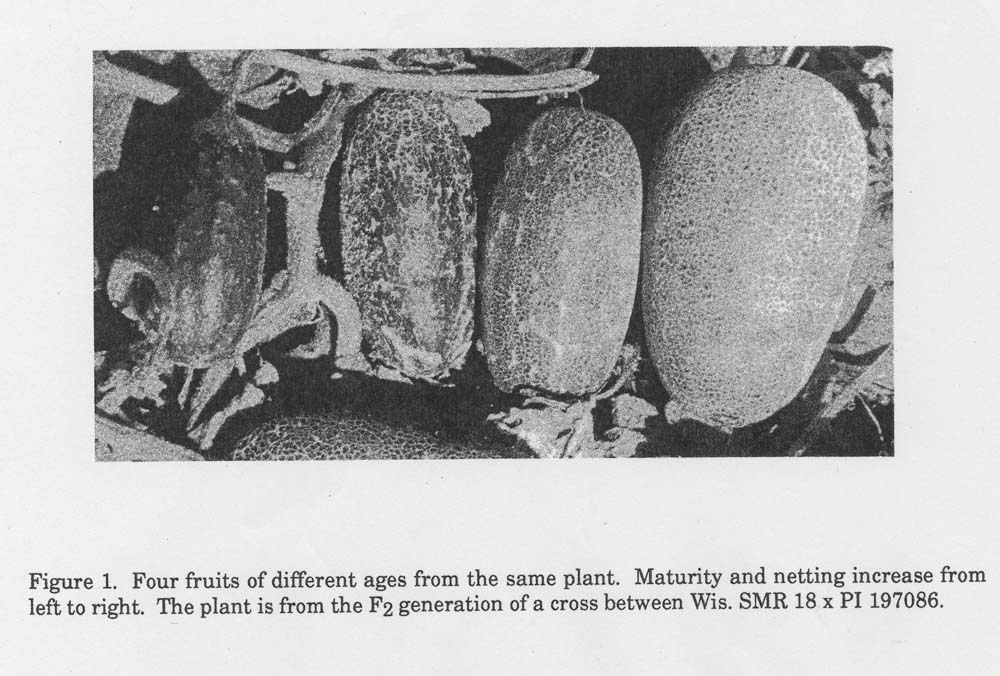Cucurbit Genetics Cooperative Report 16:8-9 (article 4) 1993
Michael S. Uchneat and Todd C. Wehner
Departmentof Horticultural Science, North Carolina State University, Raleigh, NC 27695-7609
Several fruit surface (skin) types have been identified in cucumber (Cucumis sativus L.), including warty (American), smooth (middle-eastern), ridged (greenhouse), and netted (wild). Hutchins (1940) identified the netted trait as a single gene (H) linked with black spines and red mature fruit color, and also mentioned the occurrence of intermediate netting. That trait was assigned to linkage group III by Pierce and Wehner (1990). More recently, Peterson and Pike (1992) suggested the netted skin characteristic was quantitatively inherited.
Cucumber accessions PI 197086 and PI 165509 were reported to be resistant to belly rot caused by Rhizoctonia solani Kuhn (AG-4) by Clark and Block (1984) and also have netted skin. Since that skin type is not horticulturally acceptable, belly rot resistance must be controlled by sseparate genes for those cultigens to be useful parents in a program aimed at breeding belly rot resistance. In muskmelon, it has been suggested that fruit netting provides enhanced disease resistance by acting as a physical barrier (Webster and Craig, 1976). In cucumber, it is not known whether netted skin provides a physical barrier, or whether some other mechanism is responsible for resistance.
During the summer of 1992, a study was conducted to determine whether netted skin was responsible for belly rot resistance. Both PI 197086 and PI 165509 have highly netted skin on the mature fruits. Young fruits (less than five days after pollination) do not have netted skin. Netting develops over the next few days, often starting at the ends of the fruit. At about that time, it appears that the epidermal layer stops expanding with the rest of the fruit. That phenomenon has been reported in Cucumis fruits (Webster and Craig, 1976). In the plant introduction accessions we observed, the result was corky tissue developing between pieces of the epidermis. The amount of netting increased slowly, and fruits became completely netted as they matured. In muskmelon, the skin netting was a combination of lenticellar tissue erived from a subepidermal periderm, and cork cells which were complementary tissue of lenticels (Webster and Craig, 1976). It appeared that the netting phenomenon in cucumber may be a result of the same mechanisms operating in muskmelon.
The two plant introduction accessions studied each had slightly different netting. In the case of PI 165509, the netting left the fruit with a red color, with cream colored veins (netting) over the surface. In the case of PI 197086, the netting was an obvious result of the dark, reddish-black epidermis becoming cracked, and then flaking to reveal a cream colored second layer. If the fruis were rubbed, most of the outer cracked skin layer was easily removed. It appeared that “netting” was the cracking the epidermal layer, which was red to dark maroon in color. That trait developed slowly, and resulted in what appeared to be an intermediate amount of netting on immature fruit.
The importance of this finding is that care must be taken when studying netted skin. Immature fruits may appear to be without netting, or intermediately netted, when in fact those fruits will develop complete netting if left in the field until maturity. This is a problem when ratings are made on immature fruit, and correlations to thenetted skin phenotype are desired.
Figure 1. Four fruits of different ages from the same plant. Maturity and netting increase from left to right. The plant is from the F2 generation of a cross between Wis. SMR 18 x PI 197086.

Literature Cited
- Clark, R.L. and C.C. Block. 1984. Belly rot resistance in Cucumis sativus. Phytopatho9logy 74:819 (abstract).
- Hutchins, A.E. 1940. Inheritance in the cucumber. J. Agr. res. 60: 117-128.
- Peterson, G.C. and L.M. Pike. 1992/ Inheritance of green mature seed-stage fruit color in Cucumis sativus. J. Amer. Soc. Hort. Sci. 117:643-645.
- Pierce, L.K. and T.C. Wehner. 1990. Review of genes and linkage groups in cucumber. HortScience 25: 605-615.
- Webster, B.D. and M.E. Craig. 1976. Net morphogenesis and characteristics of the surface of muskmelon fruit. J. Amer. Soc. HOrt. Sci. 101(4): 412-415.